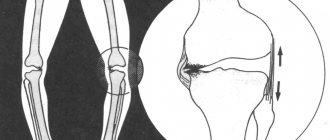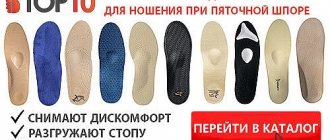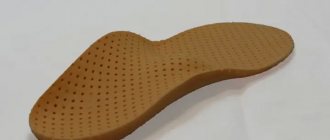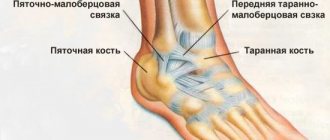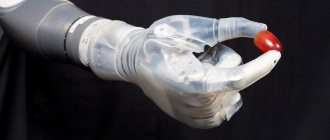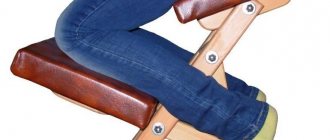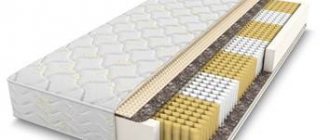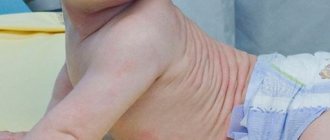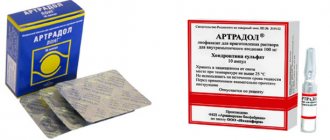Orthopedic insoles are something that is extremely necessary not only for professional athletes or people with pathologies of the lower extremities. Every person who is concerned about their health should use insoles. High-quality orthopedic insoles provide maximum comfort and relieve problems with the legs, muscles and the entire musculoskeletal system as a whole. If you want to always feel cheerful and active, it’s time to buy orthopedic insoles.
The modern market offers customers a wide range of orthopedic products for shoes. There are: frame, silicone, helium, cork insoles and many others. How to choose the most suitable option for you from all this abundance? This is what we will talk about in this article.
Classification of orthopedic insoles
In order to answer the question “how to choose the right orthopedic insoles,” you first need to understand their main types and understand the main differences between them. There are mainly four types of orthopedic insoles:
- Preventive . If you have, for example, a genetic predisposition to flat feet or varicose veins, you should definitely learn about the safety of your feet. Also, preventive insoles are necessary for everyone who has a static type of activity (standing or sedentary work), since constant stay in one position impedes blood flow. This can contribute to the development of varicose veins or flat feet.
- Corrective . In the presence of already formed pathologies of the lower extremities, orthopedists usually prescribe corrective orthopedic insoles for their treatment. It all depends on the individual characteristics of your disease, based on which the doctor will select the necessary insole model for you;
- Insoles for diabetes . Diabetic orthopedic insoles are designed specifically for people suffering from diabetes. They serve to provide additional support for weakened joints and prevent degenerative processes in the legs, which often occurs due to diabetes;
- Orthopedic insoles for children. Children's orthopedic insoles also come in both therapeutic and preventative forms. Since at an early age the child’s body begins to actively develop, bones and joints do not always have time to adapt to changes in time. The consequence of this may be flat feet. Despite the fact that children's flat feet are much more treatable, prevention is absolutely not worth neglecting, so we now recommend that you buy children's orthopedic insoles on our online store website.
Therapeutic insoles for flat feet also differ in type. For example, you can find insoles against transverse or longitudinal flat feet, as well as orthopedic insoles against hallux valgus or varus deformity of the feet. In any case, in order for the insoles to have the most effective effect, you must first consult with an orthopedic doctor. After a specialist makes a reliable diagnosis, you can buy orthopedic insoles that will be effective specifically in your case.
The main tasks of therapeutic insoles
You can learn about the functional responsibilities assigned to insoles from the following table.
Table. Tasks of orthopedic insoles
| Functions | Explanations |
| With transverse flatfoot, an elevation is created in the middle part of the insole. It is placed so that the patient does not experience discomfort while walking, but at the same time provides the necessary support for the transverse arch. The height and width of the elevation are determined individually in accordance with the intensity of the signs of pathology and the anatomical shape of the foot of a particular patient. | |
| With flat feet, deviation of the foot from the normal physiological position often develops. In view of this, in addition to the previously discussed lifting of the arch, actions must be taken to eliminate such deformation. For this purpose, additional wedge-shaped elements are included in the design of the insoles. | |
| Insoles should not only be useful, but also easy to use. That is why experts strongly recommend refraining from using standard products and ordering insoles on an individual basis. Such devices will follow the shape of the foot, which will create the best conditions for individual correction of diagnosed deformities and at the same time ensuring the most comfortable use. |
Features of the structure of orthopedic insoles
We have already figured out what types of insoles there are, but we have not found out what structural features they have. To choose the right orthopedic insoles you need to know the following:
- Preventive insoles are worn mainly in dress shoes and flat shoes and are recommended for patients after injuries and operations. Auxiliary elements and inserts are usually made of latex foam, which provides softness and comfort;
- Corrective insoles are prescribed for people with flat feet. Such liners are made on a durable frame base with a plastic instep support provided. This is the most effective type of orthopedic insoles, which helps eliminate defects of the lower extremities;
- Insoles for diabetics are made on the basis of a semi-rigid frame that fits snugly to the foot. The earbuds are made of soft foam materials that provide comfort to your feet. In addition to the frame base, there are also insoles based on gel or silicone. They are particularly flexible, elastic and have good contact with the outer surface of the feet;
- The design of children's insoles includes a special heel recess, as well as additional elements that provide arch support. The instep support is often made of natural latex.
Are insoles really effective?
According to research, insoles do have beneficial effects. But regarding this point, much is determined by the characteristics of the existing disease, or more precisely, by the intensity of its severity. The pattern is simple: the stronger the flatfoot, the more difficult it is to treat.
Under any circumstances, orthopedic insoles will ensure that the feet are fixed in an anatomically and physiologically correct position. Arch supports will help position the foot along the axis, prevent subsidence of the arches in the future and ensure proper distribution of loads on the muscles and ligaments.
In addition to flat feet itself, orthopedic insoles help combat a number of problems and pathologies that develop against the background of the first. The list is as follows:
- ensures a decrease in the intensity of pain in the legs and feet;
- the risk of arthrosis is reduced;
- the load on the spinal column is reduced, which helps improve posture;
- minimizes the risk of corns, calluses and other similar defects;
- tucking of the feet is avoided;
- gait improves;
- provides shock absorption during walking;
- muscles are unloaded.
Thus, orthotics are a very useful tool that really helps combat the problem called flat feet. You just need to choose and use them correctly. Our recommendations and medical prescriptions will help you with this.
Be healthy!
Indications for the use of orthopedic insoles
When choosing orthopedic insoles, you must take into account the following indications:
- Any type of flat feet;
- Pregnancy period;
- Arthrosis, arthritis and other joint diseases;
- Trauma post-traumatic period;
- For gout;
- Spinal disorders, poor posture;
- Diabetes mellitus and already formed diabetic foot;
- Thumb disorders;
- Any pain in the joints and lower extremities.
If you suspect that you have flat feet, there are several methods for accurately determining it. At home, this can be done using a special foot print on paper. To do this, you must first smear the surface of the foot with gouache and step on a white sheet. Based on the resulting print, one can judge the presence or absence of a flat foot. However, this at-home diagnostic method is not always accurate. We recommend that you visit an orthopedic doctor or stop by any of the Medtechnika Orthosalon stores, where, using a special plantograph, sales consultants will diagnose your flat feet on the spot for FREE and help you select and buy orthopedic insoles.
What can be done to ensure that the benefits of individual orthoses are fully realized?
Orthopedic insoles are a wonderful invention. For many problems, they can change the situation for the better, reduce symptoms, relieve pain, and slow down the development of flat feet, arthrosis or other pathologies.
But don’t think that by using orthopedic insoles, you won’t have to do anything else. The approach to the correction process should be comprehensive, including the selection of comfortable shoes, compliance with the rules of wearing insoles, regular exercises and foot massage, foot baths, and following the recommendations of the attending physician. Then you will fully experience the benefits of individually selected orthoses.
Make an appointment with an orthopedist at the Alpha Technologies MC, our specialists will not only make orthoses for you, but will also develop a set of additional corrective measures.
Insoles for athletes
When choosing insoles for sports purposes, it is very important to ensure that they distribute the load on the musculoskeletal system as evenly as possible. It is important that the joints are not overstrained and do not suffer from high loads. It is also imperative to provide good cushioning in the heel area to reduce the impact load on the feet. In this case, helium or silicone based insoles are best suited. Firstly, this will ensure maximum contact of the foot with the surface of the insole, and secondly, it will create comfortable conditions for smooth and soft movements.
Insoles for sports should have a rigid arch support that provides support for the arches of the feet, a shock absorber that improves the push-off function of the heel, and a metatarsal roller in the forefoot to prevent flattening of the arches. Training in orthopedic insoles will become more resilient and effective, and your feet will definitely thank you for the excellent care they take.
Comparison of customized and ready-made factory orthoses
There are orthopedic salons on almost every major street. Their range is rich, and in a good salon you will definitely be offered insoles that meet modern standards: with an instep support designed to support the longitudinal arch of the foot, with a Seitz roller, with heel shock absorbers. It would seem that there is everything to relieve pain.
The problem is that it is difficult for an inexperienced buyer to understand during the fitting process whether specific orthoses are suitable for him or not. It happens that they seem comfortable in the cabin, but after a few days you no longer feel comfortable. In addition, focusing on your foot size when choosing insoles is not enough. People of the same size may have different foot features—the height of the arches, the length of the toes, the characteristics of the metatarsal bones. Accordingly, the arrangement of the insole elements should be different. But in factory production there is no way to take such nuances into account; average foot parameters are used.
Meanwhile, using unsuitable insoles is fraught with more than just discomfort. A discrepancy between the parameters of the orthoses and the anatomical structure of the foot by only 2-3 mm (for example, when the transverse pad is slightly lower or slightly higher than necessary) can negate all the potential benefits of the insoles. Now let us remember that foot pathologies tend to develop. This means that with incorrectly selected orthoses, flat feet will worsen, the bump on the toe will grow, etc.
With individual manufacturing, when orthoses are made directly for you, such problems are eliminated. For example, in our clinic the service is provided by a highly qualified, experienced orthopedist. For insoles, blanks from Formthotics, one of the world leaders in the orthopedic market, are used. Manufacturing is preceded by a thorough examination of the feet using a special device called a plantoscope.
Read more about the production of individual orthoses at the Alpha Technologies MC here>>>
Rules for selecting insoles
When selecting insoles, it is important to remember that insoles are selected not by shoe size, but by foot size. It is necessary to insert the insole into the shoes in which you intend to wear inserts, so that the heel area rests against the heel, and the pelotte and arch support are located under the arches of the feet. If you bought insoles for athletics or other training, do not try to use them to the maximum right away, as you will most likely experience some discomfort in the first days. After complete adaptation of the feet, which lasts from three days to several weeks, you will be able to use the insoles every day in conditions of any intensity you need.
On average, the service life of insoles is six months (from three to ten months). The exact service life is indicated by the manufacturer on the packaging, but much also depends on compliance with the rules for using the liners. Remember that you should not wash orthopedic insoles (either in the washing machine or by hand) as you can damage the structure of the insole and it will lose its effectiveness. Try to air the insoles daily and wipe their surface with a light soap solution without using aggressive detergents or alcohol (provided that the insoles are made of leather).
General information about insoles
The insoles offered today practically do not differ in their design. As a rule, the product is equipped with an instep support (installed so as to support the inner arch of the user’s foot). The rolling zone in such conditions becomes elevated. An anatomical depression is created in the heel area. In the same place where the transverse arch is located, the so-called metatarsal pillow is installed. In some cases, the front part of the orthopedic insole is completely removed - it does not provide any clinically significant effect.
One of the main components of the products being studied today is the so-called. wedges Their forces ensure a change in the angle at which the diseased foot relates to the surface. For example, in patients with planovalgus flatfoot, the heel deviates outward from the vertical of the leg.
To correct this state of affairs, a “wedge” is placed under the heel with some thickening towards the inside of the foot. As a result, while walking, the foot will take a physiologically correct position. If there is, for example, a flattening in the area of the longitudinal arch, the therapeutic insole is equipped with a pair of wedges at once - one is placed under the front of the foot, the second - in the heel area.
The effectiveness of insoles is determined by the placement of the wedges and their height.
Arch height and flat feet
The modern lifestyle has led to many changes in the human musculoskeletal system. The use of mechanical vehicles instead of natural movement, lack of regular physical activity, wearing “unphysiological” shoes, for example, high heels or narrow toes - all this led to evolutionary changes. In frequency, it leads to a decrease in the arch of the foot and its flattening, in other words, to flat feet. During physical activity, such as running or skiing and snowboarding, this problem makes itself felt. Due to the decrease in the height of the arch of the foot, it loses its shock-absorbing properties, as a result, vibrations on a hard slope and impacts are absorbed less well; they are transmitted to the knees and spine, which have to perform an unusual shock-absorbing function.
Special anatomical insoles help dampen vibration thanks to:
- the use of soft materials in them;
- giving the arch of the foot a more natural, “arched” design;
If you have high or low arches, you need to choose insoles that are tailored to each foot type. For example, Sidas Winter 3Feet Low is molded using 3FEET technology for people with low arches. Or anatomical Sidas 3Feet high Merino insoles, specially designed for feet with high arches.
Selection for a child
Most modern children are faced with orthopedic leg pathologies. More often we are talking about plano-valgus deformity, which requires immediate correction. Delay can have a very negative impact on the child’s posture, since the disease is characterized by a decrease in the height of both arches of the foot and curvature of its axis. Treatment of pathology in children should be carried out under the supervision of an orthopedist and neurologist. Mandatory methods are massage, therapeutic exercises, swimming. Insoles also play a decisive role in the effectiveness of therapy.
A doctor knows how to choose orthopedic insoles for a child, but parents can be given a number of tips. Firstly, the products must correspond to the individual parameters of the leg, that is, making a purchase without a child is pointless. Otherwise, the therapeutic effect will not be observed. Plus, the child may experience discomfort when walking. Secondly, the product must be made from natural materials that allow air to pass freely. Another point is the exact fit to size. Selecting orthoses for growth is incorrect. Again, they should not cause discomfort to the child when moving.
The inserts should be changed periodically: this is not even due to wear, but to the rapid growth rate of the leg. It is noteworthy that unsuitable orthoses are not able to perform therapeutic or even preventive functions.
Since flat feet and other disorders are easier to prevent than to treat, wearing orthopedic insoles should be started as early as possible.
